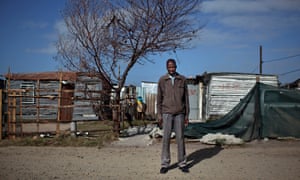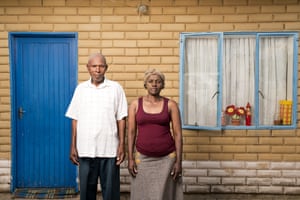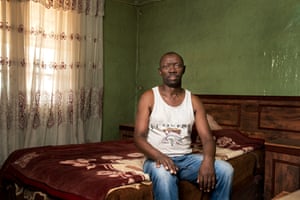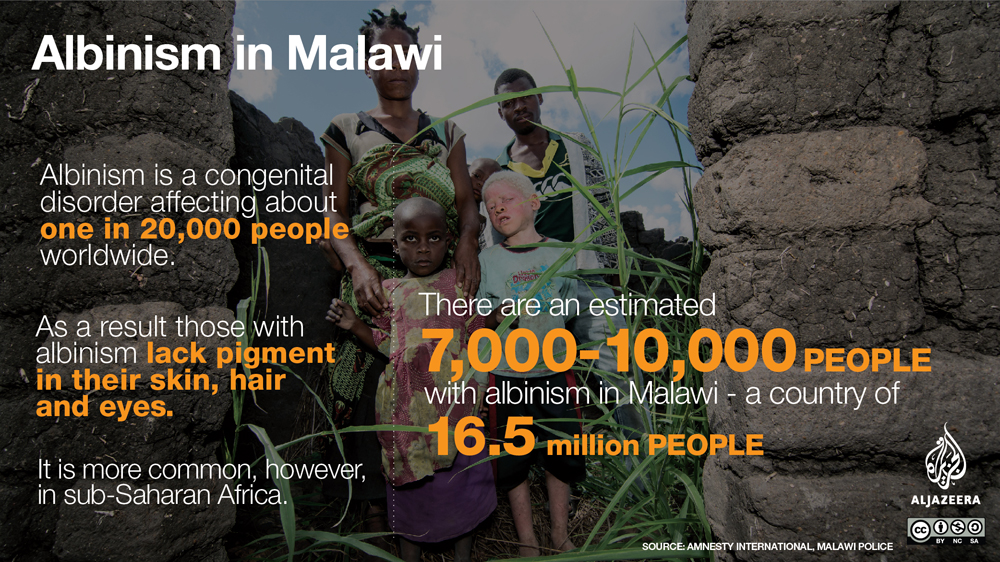South African miners given hope in battle for lung damage payouts
Court ruling paving way for class action against 30 mine companies over silicosis raises prospect of billions in compensation

uyani Elliot Dwadube walks carefully between the tidy lines of homes in Melody township, his steps kicking up small clouds of yellow dust. Decades ago, he came from his home in a village hundreds of miles away to work in the gold mines of South Africa’s Free State. With his health now failing and supported by the paltry wages of his wife, a domestic worker, Dwadube, 72, is hoping for justice before he dies.
His demands are straightforward: he wants fair compensation from his former employers for the damage done to his lungs during the years he spent drilling ore in narrow tunnels deep underground.
Dwadube suffers from silicosis, scarring of the lungs caused by fine dust inhaled underground. He is not alone. Up to 500,000 former mineworkers in South Africa and neighbouring countries are thought to suffer from the incurable occupational disease.
A groundbreaking court decision last month brought new hope to men such as Dwadube. A South African judge said human rights lawyers could launch an unprecedented “class action” that, if successful, would force more than 30 mine companies to pay compensation to everyone they have employed since 1965 who has had silicosis.
In a major breakthrough for campaigners, it would also mean payouts to relatives of former miners affected by the disease who have already died. The total sum could be billions.

Luvoko Enoch Madindala, a former mineworker near the town of Allanridge, who has silicosis, said: “This is a big victory. I never thought we would get this far. Even if we know there is still a long way to go, I will pray for us to go on and win.”
Madindala arrived in Allanridge in 1981, aged 18. For the next 30 years, he worked in the mines, using drills, picks and hammers in confined spaces deep underground. Workers were given helmets, gloves, boots and knee guards, he said, but no masks that would have filtered out the harmful dust filling the air.
“No one ever mentioned silicosis by name. No one ever explained that our lungs would be damaged through inhaling dust. They never really taught us about safety,” said Madindala, who was laid off by his employer five years ago when a doctor told him that he could no longer work.
“We used to do blasting twice a day and were working just minutes afterwards in the dust. The mines just used us up and threw us away.”.
Lawyers acting for the miners say the dangers from silica-laden dust were raised a century ago as the great South African mining boom got under way. A solution – blowing vast quantities of chilled air through the mines and masks – was also known, but only began to be implemented recently.
Georgina Jephson of Richard Spoor Inc, one of the law firms behind the class action, said: “The apartheid government effectively facilitated the whole system through the provision of cheap and expendable black labour. There have always been very good and strict laws about health and safety underground, but these were not enforced, certainly not under apartheid and only haphazardly since.”

South Africa was the world’s top gold producer for a more than a century, but it has fallen to seventh place behind Peru over the past decade. The country is thought to be the source for about one-third of all the precious metal currently in circulation.
“Mining is a very powerful industry and [it has been] in the government’s interest to allow it to prosper. Johannesburg would not be here if not for mining and our country was built on mining, but at massive expense in human life,” Jephson said.
Miners played a central role in the struggle against apartheid and the industry has long been a flashpoint. In 2012, in one of the most traumatic episodes in recent South African history, 34 miners who were calling for higher wages were shot dead by police outside a platinum mine near Johannesburg, the country’s commercial capital.
Former miners with silicosis and other diseases have long been entitled to limited compensation from a government-administered fund, to which some mining companies make a contribution. However, the sums are limited, there is a huge backlog of claims and relatives of miners who have already died receive nothing.
The court decision last month means that women such as Gertrude Ludziya, 66, could receive substantial payouts.
Ludziya’s husband died in 2002, six years after being diagnosed with silicosis. He had worked for 18 years on a mine near the two-room home near Allanridge where his widow lives. She received the equivalent of about £3,000 in compensation from the fund in 2004, but nothing else, and has to support her 14-year-old disabled granddaughter after her son-in-law, a former miner who also had silicosis, died.
“It’s really, really tough. I’ve had to let out half my house just to have enough to eat. I’ve heard about the court case and I suppose it might be good news. Or maybe not. Our need is desperate and I’m not getting my hopes up,” Ludziya said.

Some mining houses recognise that current compensation for victims of silicosis is inadequate and are eager to reach a settlement, said Alan Fine, a spokesman for six gold companies, to Associated Press shortly after the court decision to allow collective action was made public.
“The companies don’t think it is in their interests to have that hanging over them, and neither is it in the workers’ interests to have to suffer delays of the sort that would be inevitable,” he said. “We want to find a solution as soon as possible.”
The mining companies named in the action have appealed the decision, setting the scene for a long legal battle before any compensation is paid.
It takes about 10 years for miners to develop silicosis from constantly inhaling dust, according to doctors. The delay before diagnosis means that the extent of the problem is still unknown. Many of those affected by the disease are from remote rural areas, sometimes in neighbouring countries, and die without understanding the cause of their suffering. Once miners have silicosis, they are usually infected with tuberculosis.
The landscape also shows the scars of the mining industry. When Madindala worked in Target mine, there were three shafts open. Only one is now functional. Much of the gold that brought so many workers to the region has gone and huge white hills of waste rise above expanses of sparse grass on wasteland.
Pamela Dwadube, who supports her husband Elliot with her wage as a maid, said she had faith in South Africa’s justice system. “I don’t blame anyone. For a long time, I had no hope. But now I have a very big hope in me,” she said.
Burke, Jason. "South African Miners given Hope in Battle for Lung Damage Payouts." The Guardian. Guardian News and Media, 20 June 2016. Web. 20 June 2016. <https://www.theguardian.com/world/2016/jun/20/south-africa-miners-silicosis-battle-compensation-lung-damage>.
Response:
The mining industry is a core part of the South African economy but this article highlights such economic growth was at the expense of many lives. If the court case above goes further, the amount of compensation will be range in the billions as up to 500,000 former miners have been diagnosed with silicosis. The author of this article, Jason Burke, is biased against the mining companies as he focuses on the stories of victims over the excuses of large corporations. Burke does mention that some companies are willing to pay but shows them thinking about following through with compensation because it is in their best interest not to aid victims. He also shows that safety precautions were in place and silicosis was a known disease but the companies failed to educate the miners and enforce the rules for their safety. One of the miners spoken too said that a lot could have been prevented if masks have been provided. This may have been written to raise awareness about the situation and apply international pressure on the companies involved. The reality that many people were used by the mining companies and tossed out when they got sick is devastating for many who had no other job source. I hope that South Africa's justice system can reward the hope of the miners and their families that have been waiting for so long.

